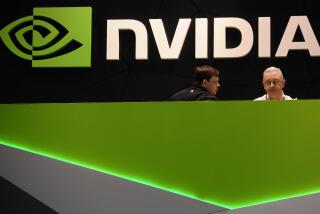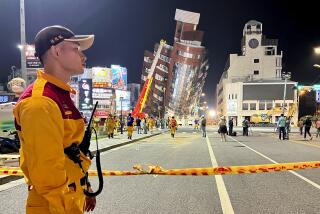Japan’s Speeding Ahead of the U.S. in Supercomputers
TOKYO — Who makes the fastest supercomputers in the world?
Increasingly, the answer seems to be Japan. That bothers American scientists, who worry that Japan’s supercomputer advantage will translate into greater Japanese competitiveness in a broad range of industries, including pharmaceuticals and semiconductors, where the machines help design new products, and automobiles, where they simulate crash tests.
The U.S. government has responded to the threat with a heavy hand. It has imposed a de facto “Buy American” policy on American government agencies and universities with respect to supercomputers. And it has included money in its proposed 1992 budget for the first portion of a $1.9-billion, five-year plan to sponsor research in supercomputers and help build a network of special supercomputer “data highways.”
This counterattack hardly has Japanese supercomputer makers shaking in their shoes.
“What we really worry about is Cray’s future,” says Akira Kuwabara, general manager of marketing at Japanese supercomputer maker Fujitsu Ltd., referring to U.S. supercomputer giant Cray Research. “We want them to be stronger. If they fail, everybody will say we crushed them.”
NEC Corp., another Japanese force in supercomputers, is pleased with the U.S. plan to build a data highway to link the $10-million machines to users around the country. The data highway would help create new demand for supercomputers by making it easier for thousands of researchers around the country to share a single machine, says Tadashi Watanabe, head of NEC’s new supercomputer marketing division and part of the team that developed the SX-3--probably the fastest supercomputer in existence today.
It isn’t hard to find the source of Japan’s confidence in this area.
Supercomputers are designed with one goal in mind: high-speed processing of complex data and problems. These machines can process in one minute what a mainframe computer might take three hours to do. This high-speed processing enables scientists and engineers to tackle such complex problems as simulating and analyzing wind patterns around an aircraft or the environmental impacts of an oil spill--problems that would be too cumbersome to handle using general-purpose computers.
Accordingly, supercomputer makers need huge amounts of money to remain at the leading edge of technology. Because sales of the machines are few and far between, they need staying power to keep investing during slow periods.
The source of Japan’s success is not in the kind of abstract research that the U.S. government tends to sponsor at university and government laboratories. Much of that research later becomes available to Japanese scientists in any case through published reports.
What makes Japanese firms strong is their broad technology base and powerful market positions in semiconductors, computers and telecommunications.
Minneapolis-based Cray Research, America’s only viable supercomputer maker, had just $784 million in sales in 1989. Its survival depends on the profitability of its supercomputers. It must spend 18% of its sales on research and even then has a research and development budget of just $143 million. One major product failure and the company is in danger of bankruptcy.
NEC, by comparison, spent $1.78 billion in research in 1989, hardly denting its $21 billion in revenue. Every breakthrough NEC makes in building supercomputers helps make its mainframe and semiconductor businesses more competitive.
When NEC recently announced a mainframe it called the fastest in the world, the critical semiconductor packaging technology was based on technology developed for its supercomputer.
“We are in supercomputers for the same reason auto companies build race cars,” says Michiyuki Uenohara, executive adviser to NEC. “It gives us leading-edge technology.”
At the international Solid-State Circuit Conference in San Francisco last month, Japanese electronics companies announced a string of impressive semiconductor breakthroughs, many applicable to supercomputers.
Fujitsu announced that it was successful in building sophisticated memory chips using gallium arsenide, a difficult-to-use material that dramatically increases the speed at which semiconductors can operate. The material is considered central to next-generation semiconductors--and the best gallium arsenide materials come from Japan.
Fujitsu also announced breakthroughs in building Josephson Junction computers, a technology for making high-speed processors that International Business Machines gave up on years ago as impractical. Fujitsu says both technologies will find their way into supercomputers that come out in the mid-1990s, dramatically increasing processing speeds of their computers.
At the same conference, NEC said it had developed new semiconductor components that would help shrink its supercomputers--now as big as a good-sized dining room--by about 70% by the end of the decade.
Cray, meanwhile, depends on outside suppliers, including rival Fujitsu, for custom-design components crucial for its next-generation systems. Not only does Fujitsu acquire important information by building semiconductors for Cray, it is up to Fujitsu whether the company chooses to share its best technology with its American competitor.
“Fujitsu could just tell Cray it is impossible to make that,” says NEC’s Watanabe. “Since we do our own semiconductor research, we know what is possible.”
Another Japanese advantage is each company’s participation in large keiretsu --business groups made up of independent companies owning portions of each other’s stocks and having interlocking directorships. These keiretsu provide ready markets for hard-to-sell supercomputers.
Twelve of the dozens of companies in Fujitsu’s keiretsu own supercomputers. Of those, 10 chose to buy Fujitsu machines. Fujitsu sold 26 more machines to government institutions and kept nine for its own use. Of Cray’s 26 sales in Japan, more than half were to companies that were not a part of keiretsu and were free to choose the kind of computer they wanted to buy.
As it did with many industries, the Japanese government played a key role in jump-starting the nation’s supercomputer industry. Between 1981 and 1989, the government spent $130 million on a project to build a supercomputer. Company officials admit that the lure of government subsidies contributed to their decision to get into a business that appeared too costly and risky to enter on their own.
Cray’s major advantage is the large library of software available to run on its machines. Cray’s machine runs about 500 packages, compared to 260 at Fujitsu, 180 at NEC and 129 at Hitachi.
Good crash-test software, for example, helped Cray sell 10 supercomputers to Japanese auto companies. At Nissan, sources say, the company was ready to buy a computer from Hitachi. Engineers, however, preferred the crash-test software on the Cray and sabotaged the deal by contacting U.S. trade officials. Nissan ended up buying a Cray and is now very happy with the machine.
Recently, Cray announced that it would expand its sales team in Japan to 150 this year--up from 90--in an effort to sell more aggressively in the Japanese market.
Cray also has on its side the mighty arm of the U.S. government. The Pentagon badgered the Massachusetts Institute of Technology when it considered buying an NEC supercomputer several years ago, and no Japanese supercomputer has sold in the United States in the past two years.
Many of these advantages, however, may be fleeting.
Japanese companies have mounted an aggressive campaign to subsidize the development of more software for their computers. Fujitsu has a five-year joint venture with the National University of Canberra to develop supercomputer software for Fujitsu machines. The company plans to make similar joint ventures elsewhere in the world and plans to pay software companies to port their software to Fujitsu machines.
NEC sold one of its last-generation machines to the Houston Area Research Center at a cut rate in hopes that the center’s staff would help the company develop software. NEC has also hired about 30 people at its Massachusetts subsidiary HNSX whose sole task is helping companies adapt their software so it runs on NEC’s machines. Watanabe says the company will complete the task of porting most important supercomputer software packages to its computer by this spring.
Japanese companies are also working together to boost their software capabilities. Next year, a four-year project involving five companies, seven users and one software house--with contributions of $7.7 million from the government--will come up with software in the area of fluid dynamics analysis. That’s used, for example, to test the aerodynamics of aircraft and autos. This kind of software has emerged as a Japanese strength.
All these advantages, of course, won’t help much if Japan is barred from the American market, by far the world’s largest. As its supercomputers improve in speed and more software becomes available, however, Japan is counting on U.S. customers to clamor for the machines. U.S. scientists point out that if Japanese computers become far superior to U.S. models, America would end up hurting its own industries by blocking their import.
The dark horse in the supercomputer race is IBM, the only company with the capability to build both computers and most advanced semiconductors. The computer giant has invested in a supercomputer market start-up by Stephen Chen, formerly one of Cray’s two leading computer architects. While the new start-up is years from coming out with a new machine, says Watanabe, “IBM is the one we have to watch out for.”
EDGE IN SPEED
Supercomputer benchmark ratings, in “lapack score,” which measures how quickly a machine measures a batch of predetermined equations (in megaflops, million floating point operations per second)
NEC SX-3: 3,897
Fujitsu VP 2600: 2,919
Cray Y-MP/8: 2,144
Source: Jack Dongarra, University of Tennessee
SUPERCOMPUTER MARKET SHARE BATTLE
Market share of all installed supercomputers worldwide, in percent.
Company 1986 1987 1988 1989 Cray 60.7% 67% 64% 53% Fujitsu 15.5 17 12 21.6 NEC 2.5 6 4 6.3 Hitachi 4.5 4 4 7.8 CDC 16.8 6 16 11.2 Machines sold 244 NA 340 412
Source: Variety of published sources






